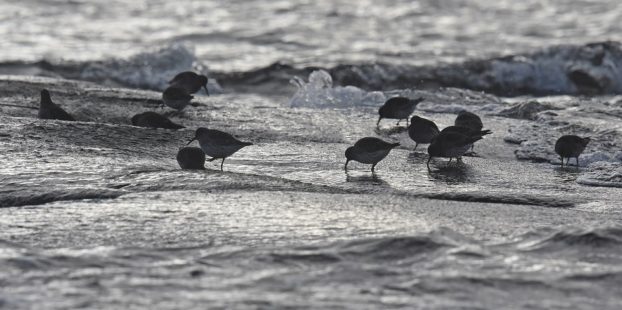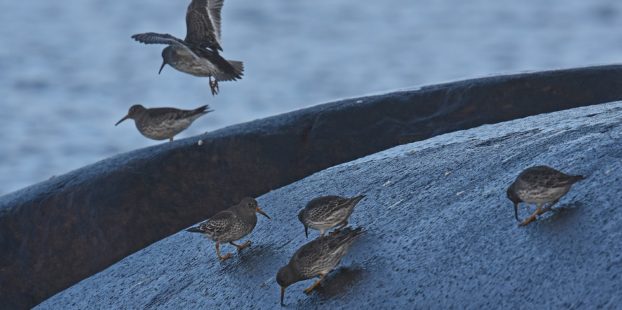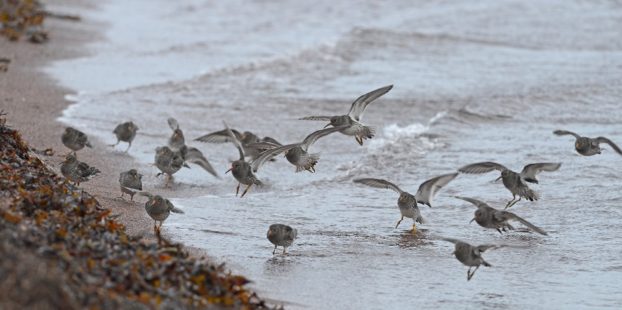Interview with William Velmala
William Velmala is a well-known birder and ornithologist in Finland. He has been active in public science, having written some hundreds of magazine articles, book reviews and book chapters on birds. He has also had many confidential posts in ornithological societies, and is currently a member of both the Nomenclatural Committee and Rarities Committee of BirdLife Finland. Last autumn William was awarded the Silver Medal of BirdLife Finland.
William has quite an array of professional posts related to birds and ornithology.
He has worked in the Finnish Ringing Scheme at the Finnish Museum of Natural History, as a PhD student at the Ecology Department at University of Turku, given bird classes at folk high schools and worked as a bird expert in a pest control company. Currently he is working as an Environmental Expert in a consultancy company Pöyry Finland Inc. and conducts field surveys on birds and bats, as well as environmental impact assessments and so on. We met William and asked about his passion for birds.
“I KEEP ON GETTING FASCINATED BY BIRDS ALMOST ON A DAILY BASIS.”
WILLIAM VELMALA
ZEISS: William, when and how did your interest in birds arise?
Velmala: I grew up in a small town where nature was present in everyday life in one way or another. The actual impulse leading me into birding took place at a school excursion when I was 12 years old. Our teacher had designed a nature track for the class and one of the activity points was to try and identify birds with the help of a bird book and a spotting scope. I immediately got hooked in putting names to birds I wasn’t even aware of before.
The event took place in May in southern Finland by the Baltic Sea, and the bay was full of displaying waterfowl and other coastal species. It was fascinating to watch these beautiful birds’ activities and learn to know them. I recall we were able to identify at least Tufted Duck, Common Goldeneye, Red-breasted Merganser and Goosander, as well as Redshank and Eurasian Oystercatcher. It was such great fun that two classmates and I decided to go out and watch birds later on. And then we did.
ZEISS: Did you already know early in life that you want to work in this field?
Velmala: Actually it was quite the contrary. At some point I did consider the possibility of becoming a biology teacher, but mostly I never wanted to get professional with birds or nature.
I regarded birding such an important hobby for me that I didn’t want to risk spoiling the fun of it. So I tried to study and work in some other fields but eventually it all came down to the fact that birds are what I’m really the most passionate about and want to work with.
ZEISS: If one works on the subject every day, can one still enjoy nature just for rest? Or is it always kind of work?
Velmala: You can enjoy it, at least in my case. I still feel like the young enthusiastic boy when the spring migration begins after a long winter, or when I search for eastern vagrants at a coastal island in the autumn, or while preparing for a bird race. But I would say birds are a lifestyle for me, rather than just a profession or a hobby, because in my case the two have been intertwined on many occasions. Of course there are things you need to take more seriously when it is your job, and you don’t always get to choose the projects you are assigned to. But even after a heavy 10-hour workday of mapping birds in a bog or forest, I can find myself at a birding site doing some casual birding.
ZEISS: Tell us about your big project with the Finnish Bird Ringing Atlas.
Velmala: I got a ringing license as soon as it was possible, that means at the age of 18 in Finland. And I had already been training for several years for it. So ringing has always been one of my absolute favourite activities, and getting involved in the ringing atlas was a dream job for me. By the time we started this massive project back in 2008 at the Finnish Museum of Natural History with Jari Valkama and Pertti Saurola, some 6–7 similar titles had already come out in Europe.
We learned a lot from the previously published atlases, but in many aspects we used our own ideas. The most important thing was to try to present the information in such a way that it could benefit bird protection. For example, we presented very detailed account on the causes of death of birds found and made an attempt to analyse these temporally and spatially. We must have succeeded well because last year the book was granted the State Award for Public Information by the Ministry of Education of Finland.

ZEISS: You have also written a few hundred popular science articles for birding magazines. What is important for you in translating science for everybody?
Velmala: There is so much variation in their plumage, habits, physiology and so on. Fortunately a lot of books are still being written and magazines published about birds, so there is basically no limit of how much you can learn. Ornithological researchers are constantly discovering all kinds of fascinating features about birds, and I want to do my share in bringing these findings within the reach of the general public.
I want people to get fascinated about birds like I do, because that’s when they realize the beauty in them. People think something is valuable and worth protecting when they have a relationship with it. If they don’t know what a Blackcap or Robin is, how could they care about them?
When they have a picture of these birds in their head, and recognize their beautiful songs in the garden, there is a much better chance they will get involved in protecting them.
ZEISS: Compared to other countries, there are relatively a lot of birders in Finland. Why do you think this is? What is special about birding and birders in Finland?
Velmala: It is said that a high percentage of Finns have a close relationship with the nature, because until fairly recently, Finland has been a relatively rural country. As a nation we are used to being able to just step out the door and meet the nature. Secondly, being situated in the North, the four seasons are remarkably different compared to each other. This gives structure for the yearly cycle and extreme variation to the characters of nature one can encounter outdoors. Thirdly, Finland is one of the most loosely-populated countries in the world.
The country is almost the size of Germany but there are only 5.5 million of us. There are only 16 Finns per square-km, compared to 233 in Germany or 393 in the Netherlands. Lastly, we have a law known as the “Everyman’s rights”, which allows one to freely make use all land of in terms of birding, trekking, camping, even picking up berries or mushroom, including private land. So there are many fantastic sites where one can freely roam and enjoy the peace of nature.

ZEISS: What is your approach concerning bird conservation?
Velmala: There is of course a lot to do in terms of nature conservation in Finland. However, one thing that is easily missed is the fact that many serious problems lie far from our homeland, along the migration routes of birds. It has become more and more evident in recent years that we also need to address these international issues in order to protect our migratory birds. It is crucial, but not enough, to protect the patch of forest where a migrant bird breeds.
However, it might never survive back to that forest, if there are a lot of habitat changes or illegal hunting or other threats on its flyway. I am also a keen bird ringer, and I consider ringing an important tool for gaining knowledge on migratory birds. My ongoing PhD project in the University of Turku, Finland, deals with the timing of different periods of the yearly cycle in the Pied Flycather, a long-distance migrant to Africa.
ZEISS: You took part in Champions of the Flyway in Israel: How did you enjoy it and how would you like to improve it from an environmental view?
Velmala: I want to give my full support to every event that ultimately benefits nature conservation, in whatever way. It can be about raising funds or awareness, and promoting nature tourism or education and change of attitudes. And it’s even better if you can do it in an entertaining way, like in the Champions of the Flyway. Who said nature conservation can’t be fun? Nobody wants to hear only bad news, so it is important to communicate afterwards what good has been achieved by the funds raised.
It motivates people if they can see what they have been able to do in practise. In my opinion we need more events like this, and I hope others will take this popular and effective event as an example and organise their own events. They don’t have to be as massive as the COTF. There is no lower limit of how much you can do good.


